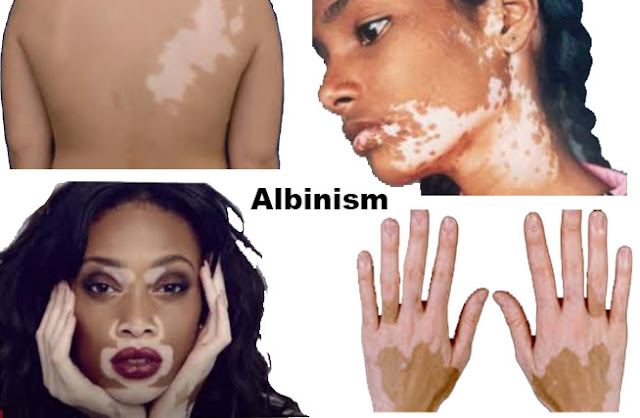 |
| Albinism |
Albinism:
The skin has a type of cell called melanocyte which produces a color called melanin and it is because of this melanin that we see the normal color of the skin. When this melanocyte becomes diseased or reduced in number or dies, the production of pigment called melanin stops and white spots appear on that particular area. Whether the skin is white or black, when the skin or skin does not have this normal color and we see an abnormal color of the skin, it is called albinism or white patient. People with diabetes or thyroid disease are more likely to develop albinism.The disease can also be caused by a particular type of anemia. Whiteness is not a contagious or deadly disease. As a result of albinism, white spots appear on the skin. Albinism can occur in a few parts of the body, on the left or right side of the body, and in most parts of the body. It can happen to anyone. Whiteness is usually seen in the exposed parts of the body. This disease is also called white disease in rural areas. There are many negative ideas and superstitions in our society about albinism. Scientists do not yet know the exact cause of this disease. At present, about 100 million people around the world are affected by this disease. Many people think that albinism and leprosy are the same thing. But this is a completely wrong idea. Whitening is not a contagious disease at all and in most cases the patient recovers completely with the help of treatment.
Causes of albinism:
It is not a dangerous disease. The exact cause
of albinism has not yet been confirmed. However, the disease can be due to the
following reasons:
- Hereditary factors can cause this disease in some people. In some cases, the disease is seen after a few generations.
- Allergic reactions to chemicals or synthetics used in cosmetics can cause whitening.
- If the frame of the glasses is too tight, it may turn white on either side of the nose or near the ears.
- May occur if the body is deficient in immunity.
- The sun can cause skin burns or stress.
- In many cases whitening can also start from the synthetic tip of the forehead.
- Prolonged use of plastic or rubber shoes, watches, etc. can also cause whitening or other skin problems.
Signs and symptoms:
By looking at the signs and symptoms of albinism,
one can easily get an idea about the presence of this disease. Signs and
symptoms are:
- There will be white spots on the skin,
- At a young age the hair, eyelids, eyebrows or beard will turn white or gray,
- The tissues on the inside of the face will be colorless, the inside of the eyes will be discolored or colorless.
Albinism test:
Physicians can make decisions by knowing the history of the disease and the history of the disease in the family. This disease is usually diagnosed by looking at the symptoms without any laboratory tests. If the doctor thinks it is necessary, then he can suggest to do skin biopsy, blood test or eye test.
Treatment of albinism:
Treatment of albinism may not be complete for a long time. In general, 50 to 75 percent of patients are completely cured of the disease through treatment. The patient has to wait a long time for the treatment of albinism to recover. Treatment of hairy parts of the body is successful in many cases but treatment of parts that do not have hair, such as fingers, lips, etc. can take a long time. Again in many cases the patient can heal on his own. Of course, ointment, medicine or therapy should be taken according to the doctor's advice. Not all medical procedures work in the same way for everyone. The age of the patient, the location and extent of the disease determine the medical procedure. Again the skin can be replaced if necessary. Oral steroid tablets, riboflavin tablets and various doses of tacrolimus or pimecroliums cream, corticosteroid ointment, calcipotriene ointment etc. are commonly used as medicines. In the case of phototherapy or laser treatment, Narrowband Ultraviolet-B, PUVA, laser therapy, etc. may be applied alone or in combination with other treatments. Cosmetic surgery can be done if the treatment does not work for two years or more or the white spots remain stable. There are different types of surgical treatments such as epidermal grafting, autologous mini graft, transplantation of cultured or non-cultured melanocytes etc.




0 Comments